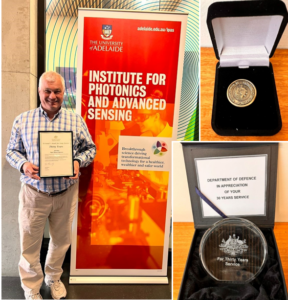Congratulations to Training Centre member, Professor Nigel Spooner, for his ‘Secretary’s Award for Long Service – 30 years’, awarded for his work in the Australian Public Service. Nigel worked at ANU for 10 years followed by 20 years at DST Group. Nigel leads the Prescott Environmental Luminescence Laboratory at the University of Adelaide and the Centre for Radiation Research, Education and Innovation. Thank you for all your years of hard work Nigel.

Nigel’s researcher profile:
Professor Nigel Spooner was awarded a DPhil (Physics, Oxon) in 1993, following which he relocated to establish and head the “Luminescence Dating Laboratory” (LDL) at RSES, Australian National University, Australia. Research focussed on environmental dosimetry utilising luminescence induced in artificial and naturally-occurring environmental materials by ionising radiation from natural and man-made sources in the environment. Work included elucidation of the physics and phenomenology of thermoluminescence (TL) and optically-stimulated luminescence (OSL) from these materials for dosimetry, the development of Luminescence Dating (TL & Optical Dating) protocols, and the invention of apparatus for environmental dosimetry research and application. Devices included the world’s first commercially-manufactured Optical Dating system, including luminescence readers, automated alpha particle and beta particle irradiators and specialised calibration facilities, in collaboration with Littlemore Scientific Engineering (Elsec), Oxfordshire, UK. Applications included the use of TL and Optical Dating for “retrospective dosimetry” (Dose Reconstruction) in the modern era. A key focus of the LDL was reaching into past times using radiometric dating: Optical Dating in particular had “broken through” to gain recognition as a major new chronological technique. This enabled the team to address major questions in geomorphology, soil science, palaeohydrology, archaeology and palaeontology, leading to numerous publications including cover articles in the journals Nature and Science.
Nigel transferred to DST Group in 2002, from where he initiated the joint DST Group-University of Adelaide Luminescence program from 2004. This was later incorporated as a founding element of the successful Institute for Photonics and Advanced Sensing (IPAS), and was renamed the “The Prescott Environmental Luminescence Laboratory” (PELL). The PELL boasts a globally-unique suite of instruments for luminescence analysis, radiation exposure detection and radiometric dating. Activity areas include retrospective dosimetry, radiation detection technology development including a novel class of radiation-sensitive optical fibres and single-sand-grain Optical Dating apparatus, TL research, and environmental radioisotope and dose-rate measurement. The laboratory possesses world-leading technology, hosting the most sensitive TL spectrometer, and the world’s most sensitive radiogenic luminescence imaging technology for spatially-resolved OSL & TL imaging.
